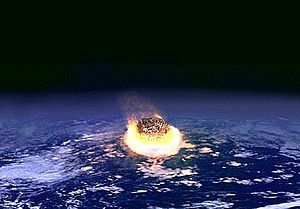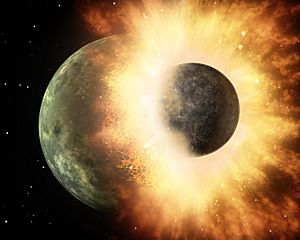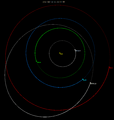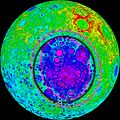Impact event facts for kids

An impact event happens when two objects in space crash into each other. These collisions happen all the time in planetary systems, like our own Solar System. Most of the time, the objects are small, such as asteroids, comets, or meteors. These small impacts usually don't cause much trouble.
However, when a really big space object hits a planet like Earth, it can have huge effects! Scientists try to predict when a large object might hit Earth. Luckily, our planet's atmosphere helps protect us. It slows down and breaks apart smaller objects. These often explode high up in the air and are seen as bright streaks called bolides.
Contents
Space Rocks Hitting Planets
You can see giant holes called impact craters on many planets and moons in our Solar System. These craters are proof of past collisions. Some of the biggest ones are on Mars and our own Moon.
The first time humans actually recorded an impact event was in July 1994. A comet named Comet Shoemaker–Levy 9 broke into many pieces and crashed into the giant planet Jupiter. Scientists watched this amazing event using powerful telescopes and satellites.
How Impacts Shaped Our World
Impact events have played a big role in how the Solar System has changed over billions of years. They have also greatly shaped the history of the Earth, including the evolution of life.
One of the most famous impacts happened about 66 million years ago. A huge space rock hit Earth, creating the Chicxulub crater. Many scientists believe this impact caused the extinction of the dinosaurs and many other living things. There's still a lot of discussion about whether other impacts caused other mass extinctions throughout history.
Scientists also think that a massive impact event created our Moon. This idea is called the Giant impact hypothesis.
Impacts on Earth Today
Hundreds of impact events have been reported on Earth. Many of them happen without anyone on the ground even noticing.
- Small asteroids, about 4 meters (13 feet) wide, hit Earth about once a year. They usually explode high in the upper atmosphere, turning into vapor.
- Larger asteroids, about 1 kilometer (0.6 miles) wide, collide with Earth roughly every 500,000 years.
- Very big collisions, from objects about 5 kilometers (3 miles) wide, happen only once every twenty million years.
While some smaller asteroids have caused damage and injuries, no human is known to have died directly from an impact. The Chelyabinsk meteor event in 2013 is the only known impact that caused a large number of injuries. This space rock was about 20 meters (65 feet) wide.
One of the most well-known impacts in recent history was the Tunguska event. This happened in Siberia, Russia, in 1908. An object exploded in the air, flattening millions of trees over a huge area. Impacts of that size are thought to happen about once every thousand years.
Related pages
Images for kids
-
A bolide glowing brightly as it enters Earth's atmosphere.
-
Eugene Merle Shoemaker was the first to prove that meteorite impacts have affected the Earth.
-
An aerial view of Barringer Crater in Arizona, a famous impact site.
-
Trees knocked over by the powerful Tunguska blast in 1908.
-
The trail left by the exploding Chelyabinsk meteor over the city in 2013.
-
A map of the South Pole–Aitken basin on the Moon, showing evidence of a huge impact 4.3 billion years ago.
-
A dark scar left on Jupiter by Comet Shoemaker–Levy 9 after its impact.
-
The Hubble Space Telescope showing debris from asteroid P/2010 A2, likely from a collision with a smaller asteroid.
See also
 In Spanish: Impacto astronómico para niños
In Spanish: Impacto astronómico para niños













